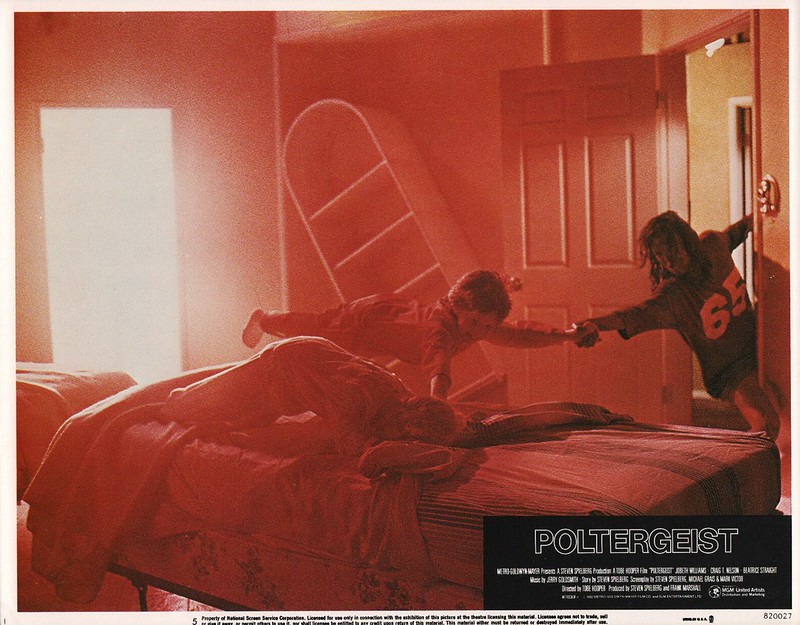This is the time of year when I’m normally planning our annual “Halloween Horrorfest” at the Pickwick Theatre Classic Film Series. Since there will be no screening this year with the program in mothballs, I thought I’d look back on a film that made a lasting impression on me. It was– and remains– the scariest movie I ever saw in a movie theatre. The fact that I saw it at the show is what made the experience even more special. So I thought for this Halloween season, I’d look back on a modern horror classic that explored the paranormal, 1982’s Poltergeist.
The summer of 1982 was right in the middle of a period in which I was heavily influenced by the blockbusters of the era. Several of these films were made by George Lucas and Steven Spielberg, of course. By 1982, audiences were just a year past Raiders of the Lost Ark and a year ahead of Return of the Jedi. I associate all these wonderful films with my childhood. At that time, I was about the same age as the younger children in Poltergeist. Like them, my bedroom was filled with Star Wars toys! I could relate to them. In fact, I was only about seven months older than child star Heather O’Rourke, who played “Carol Anne.”
Poltergeist tells the story of a suburban family in California whose daily routine is interrupted when they are visited by the supernatural. These dark forces reach out to the youngest in the family, Carol Anne– via the television set– and ultimately claim her. A poltergeist exists within the home– a terrible presence that is “strong enough to punch a hole in this world.” There are reasons that this family is being singled out, but for those who haven’t seen the film, all I can say is that it has something to do with land development.
JoBeth Williams and Craig T. Nelson star as the parents, Diane and Steven Freeling. Both are fine actors, but this was probably the most memorable thing that either did. Heather O’Rourke, who beat out Drew Barrymore for the role, is adorable as Carol Anne. She would utter one of the most famous lines in movie history: “They’re heeeere!” The rest of the actors are well cast. But as I watch it now, all these years later, there is a certain sadness that hovers over the film. Composer Jerry Goldsmith’s haunting lullaby, so much associated with the film, certainly contributes to this melancholy. I can’t help but get emotional not just by what is shown on the screen, but in the knowledge that real-life tragedy befell some in the cast. Dominique Dunne, who played the older sister, was murdered late in 1982 by her ex-boyfriend. Then in 1988, Heather O’Rourke tragically passed away at the age of 12 from congenital stenosis of the intestine.
Poltergeist was directed by Tobe Hooper, although the extent of his involvement and authorship has come under question over the years. Steven Spielberg wrote and produced it, but he was prevented from officially “directing” it because he was preparing E.T. The film certainly has stronger ties to E.T. than to Hooper’s Texas Chainsaw Massacre! Kids and suburbia were Spielberg’s stock and trade at that time, and it certainly feels like a Spielberg film.
Poltergeist is essentially a ghost story, but like none other before it. It has been pointed out that there are elements in it that recall the Twilight Zone episode “Little Girl Lost” (1953), in which a character is adrift in another dimension. Like other films in the horror genre, Poltergeist‘s story gives you that long-sought resolution followed by a growing sense of unease. You think the film is over until it just goes bonkers at the end. Audiences at the time left the theatre feeling satisfied!
What I saw in the theatre in 1982 still gives me chills in 2020. Poltergeist strikes a chord with our collective fear of the unknown. Who can forget that terrifying image of Carol Anne being sucked into the light of her bedroom closet, or the nightmarish tree blown away by a tornado, or the image of that frightening clown puppet that sits on a chair one moment and is gone the next. The film evocatively stirs our primal fear of the dark, and yet all the shocks are grounded by real human emotion. It’s a mother’s love for her missing child that gives the film its heart– a mother’s voice trying to call her baby back to the world of the living. We feel compassion for these characters.
Two sequels would follow beginning with Poltergeist II in 1986. Poltergeist III (1988) would be released just months after O’Rourke’s untimely death. In three of these films, she escaped death only to succumb to it when the cameras stopped. The third film, which I have never seen, probably should not have been made given O’Rourke’s health issues at the time. But neither of these follow-ups, or the ensuing remakes, ever captured the intensity of the original, as is so often the case in Hollywood. But I’ll always remember the experience of seeing the original in a theatre– and that crowd-pleasing final shot of Craig T. Nelson at the Holiday Inn.
~MCH

